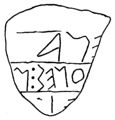CO·71: Difference between revisions
No edit summary |
|||
| (One intermediate revision by the same user not shown) | |||
| Line 28: | Line 28: | ||
|source_detail=Morandi 2004: 622 f. no. 147 | |source_detail=Morandi 2004: 622 f. no. 147 | ||
|checklevel=3 | |checklevel=3 | ||
|problem=Giussani, E unten weg? | |problem=Giussani, E unten weg? is der dritte Balken von M da? | ||
}} | }} | ||
==Commentary== | ==Commentary== | ||
| Line 35: | Line 35: | ||
Images in {{bib|Tibiletti Bruno 1969b}}: 273, tav. I.1a (drawing from '''{{bib|Giussani 1927}}: 147, fig. 8''') and 1b (photo), {{bib|Solinas 1995}}: tav. LXVII.d (photo), {{bib|Morandi 2004}}: 621, fig. 20.147 (drawing). | Images in {{bib|Tibiletti Bruno 1969b}}: 273, tav. I.1a (drawing from '''{{bib|Giussani 1927}}: 147, fig. 8''') and 1b (photo), {{bib|Solinas 1995}}: tav. LXVII.d (photo), {{bib|Morandi 2004}}: 621, fig. 20.147 (drawing). | ||
The remains of three lines are preserved on the roughly triangular fragment; they are separated by frame lines, but the frame above line 1 in Giussani's drawing is not certain. Line 1 ends on the fragment, while lines 2 and 3 are incomplete at both ends. Reading from {{bib|Whatmough 1933}} (PID): 630, no. 299 bis based on Giussani's drawing. The reading of lines 1 and 2 is clear, though only the tips of the three bars are left of epsilon in line 1, and the fourth bar of mu in line 2 may just be missing (pace {{bib|Tibiletti Bruno 1969b}}: 174); at the beginning of line 2 the very tip of a bar may be made out (ibid.). In line 3, which is not preserved in its full height at any point, the first preserved letter could as well be alpha; according to Solinas, only a single hasta can be made out today. The letters of line 1 are larger than those of line 2; {{bib|Tibiletti Bruno 1969b}}: 173 f., no. 1, assumes that line 2 predates the others. See also {{bib|Tibiletti Bruno 1978}}: 142 f., {{bib|Prosdocimi 1986}}: 238, {{bib|Tibiletti Bruno 1990b}}: 106 f. | The remains of three lines are preserved on the roughly triangular fragment; they are separated by frame lines, but the frame above line 1 in Giussani's drawing is not certain. Line 1 ends on the fragment, while lines 2 and 3 are incomplete at both ends. Reading from {{bib|Whatmough 1933}} (PID): 630, no. 299 bis based on Giussani's drawing. The reading of lines 1 and 2 is clear, though only the tips of the three bars are left of epsilon in line 1, and the fourth bar of mu in line 2 may just be missing (pace {{bib|Tibiletti Bruno 1969b}}: 174); at the beginning of line 2 the very tip of a bar may be made out (ibid.). In line 3, which is not preserved in its full height at any point, the first preserved letter could as well be alpha; according to Solinas, only a single hasta can be made out today. The letters of line 1 are larger than those of line 2; {{bib|Tibiletti Bruno 1969b}}: 173 f., no. 1, assumes that line 2 predates the others. See also {{bib|Tibiletti Bruno 1978}}: 142 f., {{bib|Prosdocimi 1986}}: 238, {{bib|Prosdocimi 1987}}: 574, {{bib|Tibiletti Bruno 1990b}}: 106 f. | ||
Dated palaeographically to the 5<sup>th</sup> century BC by Morandi. | Dated palaeographically to the 5<sup>th</sup> century BC by Morandi. | ||
{{bibliography}} | {{bibliography}} | ||
Latest revision as of 17:21, 25 January 2025
| Inscription | |
|---|---|
| Reading in transliteration: | ]ẹna / ]ones : ṃ[ / ]ẹị[ |
| Reading in original script: | ] ] |
|
| |
| Object: | CO·71 San Fermo della Battaglia (slab) |
| Position: | front |
| Frame: | ? |
| Direction of writing: | sinistroverse |
| Script: | North Italic script (Lepontic alphabet) |
| Letter height: | 12–15 cm4.724 in <br />5.906 in <br /> |
| Number of letters: | 10–11 |
| Number of words: | 4 |
| Number of lines: | 3 |
| Workmanship: | carved |
| Condition: | fragmentary |
|
| |
| Archaeological culture: | unknown [from object] |
| Date of inscription: | unknown [from object] |
|
| |
| Type: | unknown |
| Language: | prob. Celtic |
| Meaning: | unknown |
|
| |
| Alternative sigla: | Whatmough 1933 (PID): 299 bis Solinas 1995: 95 Morandi 2004: 147 |
|
| |
| Sources: | Morandi 2004: 622 f. no. 147 |
Images
Commentary
First published in Giussani 1927: 145–148.
Images in Tibiletti Bruno 1969b: 273, tav. I.1a (drawing from Giussani 1927: 147, fig. 8) and 1b (photo), Solinas 1995: tav. LXVII.d (photo), Morandi 2004: 621, fig. 20.147 (drawing).
The remains of three lines are preserved on the roughly triangular fragment; they are separated by frame lines, but the frame above line 1 in Giussani's drawing is not certain. Line 1 ends on the fragment, while lines 2 and 3 are incomplete at both ends. Reading from Whatmough 1933 (PID): 630, no. 299 bis based on Giussani's drawing. The reading of lines 1 and 2 is clear, though only the tips of the three bars are left of epsilon in line 1, and the fourth bar of mu in line 2 may just be missing (pace Tibiletti Bruno 1969b: 174); at the beginning of line 2 the very tip of a bar may be made out (ibid.). In line 3, which is not preserved in its full height at any point, the first preserved letter could as well be alpha; according to Solinas, only a single hasta can be made out today. The letters of line 1 are larger than those of line 2; Tibiletti Bruno 1969b: 173 f., no. 1, assumes that line 2 predates the others. See also Tibiletti Bruno 1978: 142 f., Prosdocimi 1986: 238, Prosdocimi 1987: 574, Tibiletti Bruno 1990b: 106 f.
Dated palaeographically to the 5th century BC by Morandi.


